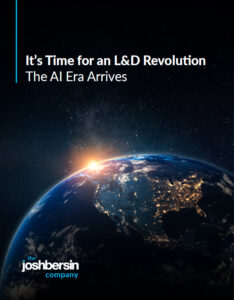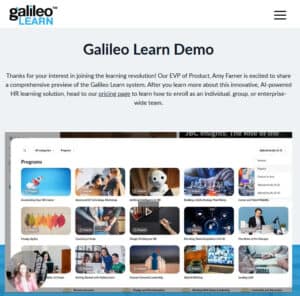As many of you know, we believe we’re beginning a massive AI revolution in corporate learning. This revolution will dramatically change what L&D does, how L&D operates, and how the content and coaching market evolves. In this article I’ll update you on the major vendors and give you a roadmap for evolution.
 Paradigm Shift: From Publishing to Dynamic Content Generation
Paradigm Shift: From Publishing to Dynamic Content Generation
As our just-published research study explains in detail, the fundamental shift in AI-native learning is dynamic content. Unlike the publishing model we’ve used in training for decades, now you can dynamically (soon in real time) build content to meet each employee’s needs. And that means you’re no longer an “L&D” function, but more. You’re now responsible for training, skills development, information distribution, and enablement.
(In some sense, the whole idea of a “course” goes away.)
Consider a common scenario: you’re training your sales teams on products, features, and competitors. You build videos, courses, and role-plays to help. Then suddenly a new regulatory change takes place and your positioning and competitive situation changes. Do you “refresh” all the content? Or simply have a conference call?
With an AI-native learning platform you could literally upload the new regulatory documents along with a Q&A and the “learning platform” can update content, build a virtual coach, and simply “answer questions” like “what is the impact of this regulatory change on our sales message?”
This shift, from the legacy SCORM, course-based model to one of dynamic content, is enormously profound.
Not only does L&D go faster and become more relevant, but your entire operation can change. Now you can let business units author and update their own content; you can dramatically save money on instructional design; and you can move your operation to a much more “business-centric” operating model. (All this is explained in our Corporate Learning Revolution study.)
How To Adapt: Platforms Are Changing
As I explained in my recent podcast, most companies already have an LMS and lots of learning in place. No doubt you have onboarding, management training, DEI courses, and lots of technical training. The e-learning market started in 1998, so we’ve literally had 27 years of content development, authoring, and publishing built from the old paradigm.
How do we move to this new model adeptly so we can gain the benefits of speed, agility, and personalization that AI provides?
Well there are a variety of new platforms to help. Our platform Galileo Learn? is one, built on Sana, designed to get you started quickly. And Sana is an AI pioneer, with one of the most advanced platforms in the market.
But other vendors are moving fast, so let me talk about the players.
The “big LMS vendors” in the market today are as follows: Cornerstone, Docebo, Workday, SAP, and Oracle. (And there are hundreds of others.)
Today these vendors fall into two broad categories: those with traditional LMS architectures (built around SCORM, compliance, skills-models, and role based learning) and those with AI-native architectures.
 Cornerstone, as I discuss in this weeks podcast, is a traditional architecture LMS, enhanced with AI features and an integrated skills system from SkyHive. With 7,000+ customers and a massive install-based of industry implementations, they are the biggest vendor in the market. Cornerstone Galaxy, the company’s new platform, is one of the best in the traditional architecture, now highly supported by new AI features (automatic development planning, course recommendation, content discovery, etc.)
Cornerstone, as I discuss in this weeks podcast, is a traditional architecture LMS, enhanced with AI features and an integrated skills system from SkyHive. With 7,000+ customers and a massive install-based of industry implementations, they are the biggest vendor in the market. Cornerstone Galaxy, the company’s new platform, is one of the best in the traditional architecture, now highly supported by new AI features (automatic development planning, course recommendation, content discovery, etc.)
Docebo, the other major independent LMS vendor (publicly traded), just unveiled its AI-native system. And this platform is for real.
I talked with the Docebo founders more than six years ago about their AI architecture and at the time it felt like a distraction. That long-term investment has now paid off, and last week Docebo unveiled its “All-AI” platform, which includes dynamic content generation, virtual coaching (in beta), use-case based instructional templates, and collaborative content design.
While Docebo is not an “All-AI” company like Sana and some of its features are new, Docebo qualifies as a dynamic content system. Docebo has more than 3900 large customers and deep experience in most industries, customer education, and all sorts of high-scale learning business models.
Sana, the vendor we partner with for Galileo and Galileo Learn, is an “all-AI” native system with its own AI agent. While it does not have the e-commerce and industry experience of Cornerstone or Docebo, we believe it is the most “pure-play” revolutionary platform on the market. After more than two years working with the company on our Galileo offering, we believe they’re a disruptor and important new vendor in the space. (Workday uses Sana for its internal leadership academy.)
The HCM vendors Workday, SAP, and Oracle will get there over time. These vendor products, each of which have a very different history, are not yet “AI-native” in their design. While each is working hard on many AI-powered features, their learning platforms have yet to move in this direction.
Others L&D vendors to watch include Arist (AI-powered micro-learning), Uplimit (AI-native technical training and softskills), CodeSignal (AI-native simulation and testing), and new AI-native caoching tools from Hone, BetterUp, and Valence. And development tools like Synthesia, EasyGenerator, and Articulate are popping up everywhere. (I would not be surprised to see OpenAI offer a “course builder” option within ChatGPT.)
So What Should You Do?
Here’s how we recommend you proceed.
First, regardless of the platform you have today, it’s time to experiment with dynamic content.
You don’t need to replace or disable your LMS to build a new, employee-facing experience based on one of these new platforms. You can get started with Galileo Learn? for only $495, for example, and you’ll see how dynamic content creation and distribution works.
As one of our large pharma companies is doing, you can keep your compliance and operational content running in your LMS as you move areas like leadership development, tech training, softskills, sales, and other user-centric programs to the dynamic content model. This gives you the flexibility to quickly build globalized content and learn how the AI features work as you maintain operational training in place.
Second, start experimenting with AI tutors, virtual agents, and AI coaching.
Our platform has a built in AI Tutor as well as an “Ask Josh” feature, both of which are trained on 700+ courses. These interfaces create a high level of engagement and stickiness with users and help you understand what real “learning in the flow of work” will look like. And as I describe above, there are many others to try.
Remember that an AI tutor without your company’s content may be of limited value. Since the AI “coaching” intelligence is almost a commodity, look for a vendor with trusted content and one that has robust tools to help you load your own company’s documents, videos, and courses.
Third, start working directly with your company’s AI team within IT.
Most of their efforts have been focused on AI Assistants or AI based recruiting, talent, and HR self-service. These same systems can now deliver learning as well. I talked with a large retailer L&D leader and once I explained this new architecture she jumped up and told me she was going to immediately start meeting with the company’s AI Chatbot team, which already delivers an AI service to employees.
In our case, the Galileo Agent (which is now used by thousands of HR professionals) can directly access Galileo Learn in the results window, bringing learning right into an employee’s AI experience. Docebo just announced its Project Harmony, a neural search feature that lets Docebo users ask questions of the Docebo corpus as if it were an AI tool. Most likely other vendors will go this way as well.
Fourth, start to spend more time with your line of business users (in other words, get out of HR).
You’ll realize they have dozens of information, process, and enablement needs that can take advantage of dynamic content. Imagine a retail restaurant chain that wants to share best-practices for store operations (this is a real-world example). They could literally video or record interviews with line managers and put it into your learning platform for distribution. Now your learning platform is an “in the flow of work” employee enablement system.
There are lots of new avenues to explore here, and you don’t have to throw away the systems you have (not yet, at least). Even projects like skills-based learning can be automatically solved by AI (Sana, for example, infers and assesses skills based on user activity, functioning as a talent intelligence system on its own).
It’s a whole new world, and the benefits can be rapid and significant. It took us only 5 months to migrate all our Josh Bersin Academy over to Galileo Learn and you can do the same. The result? Faster content delivery, automatic language translation, and a personalized learning experience for every user. (And your L&D team will be freed up to spend more time with managers.)
We’re going to be doing workshops on this at all the major conferences in the next year, so reach out to us for help. And to get started, get your hands on Galileo Learn as a good way to start your own revolution. And if you have some fantastic experiences to share, please contact us.
Additional Information
Dynamic Content in Action: See Galileo Learn Demo
Join our L&D Disruption Research Study and see the results
Does AI Stunt Learning? In Some Cases Yes.